-
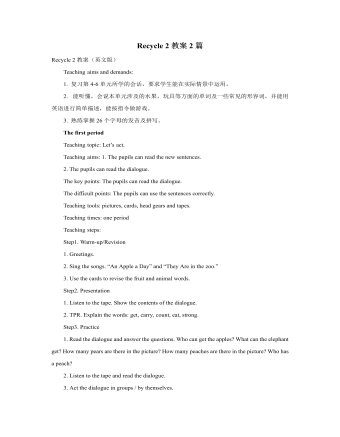
人教版新课标PEP小学英语三年级下册Recycle 2教案2篇
第三课时教学设计方案【教学内容和目标】【教学重点】 制作键盘; 学唱英文歌曲 “A B C Song ”。【教学难点】复习过程中的兴趣培养;【教具准备】1 教材配套的录音带。2 教师和学生分别准备废旧的硬纸盒/纸版、剪刀、胶水。3 教师准备一个自己已制作好的键盘。4 教师准备字母卡片和真正的键盘一个。【教学过程】1 热身、复习 (Warm-up/Revision)(1)师生之间进行英语对话或进行日常口语活动。(2)学生之间自编对话并表演。(3)教师播放B Let’s chant 的录音,让学生边拍手边说歌谣。(4)游戏:Silent Speech教师换一种方法说字母------唇说,说字母的时候不发出声音。学生看教师的口形,猜教师“说”的内容。说的字母为Aa----Zz 。2 呈现新课 (Presentation)(1)教师出示字母卡片,学生认读字母Aa----Zz。(2)学生字母背诵Aa----Zz。(3)教师播放歌曲 “A B C Song ”,告诉学生“试一试”“比一比”,看看谁能通过自己试唱学会歌曲。
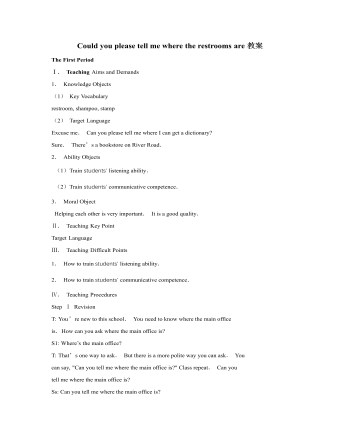
人教版新目标初中英语九年级下册Could you please tell me where the restrooms are教案
Step Ⅰ RevisionCheck homework. Ask a few students to read the article in 3a.Then ask a few students to read their guides.Step Ⅱ Part 1Look at the words in the box. Ask a student to read them. Make sure the students understand the meaning of the words. You are to fill in the blanks with the words. In some cases, students may need to use another form of the word, for example adjusting for tense or subject/ verb agreement.Ask students to fill in the blanks on their own.Check the answers. Step ⅢPart 2Go through the instructions with the class.Look at the example with the students.Ask students what the answer would be.Ask a student to read the question and answer it.Excuse me, could you tell me where the bank is, please?The bank is across the street from the shopping malt.Get students to complete the work in pairs.Check the answers. Ask a few students to read their questions.Step Ⅳ Just for Fun!Ask all the students to read the conversation. Ask: What is funny about this cartoon? Help students to explain. A Martian is a person from the planet Mars.There is no such thing as Martian food on Earth, and the clerk looks silly because he is trying to think of where there is a Martian restaurant.Invite some pairs of students to present this conversation to the rest of the class.Step Ⅴ Summary and HomeworkIn this class, we’ve done much writing practice using the key vocabulary words and the target language presented in this unit. After class, please finish the questions in 2 in your exercise books. Then finish the exercises on pages 47~48 of the workbook as well.The Seventh Period Ⅰ Teaching Aims and Demands1. Knowledge Objects(1) Key Vocabularyimage, adventure, jealousy, hero, crime, journey, brave, no longer, show interest in, take it easy, become interested in, plain looks(2)Text:Grown-ups like cartoons, too.2. Ability Objects(1) Fast-reading to get a general idea of the text.(2) Careful-reading to get the detailed information in the text.
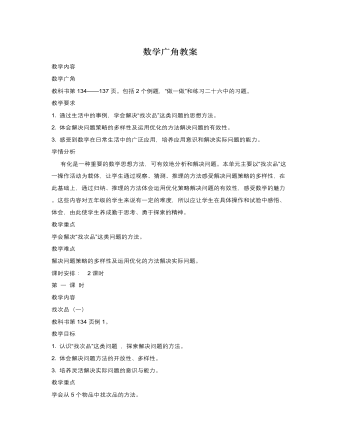
人教版新课标小学数学五年级下册数学广角教案
教学要求1. 通过生活中的事例,学会解决“找次品”这类问题的思想方法。2. 体会解决问题策略的多样性及运用优化的方法解决问题的有效性。3. 感受到数学在日常生活中的广泛应用,培养应用意识和解决实际问题的能力。学情分析有化是一种重要的数学思想方法,可有效地分析和解决问题。本单元主要以“找次品”这一操作活动为载体,让学生通过观察、猜测、推理的方法感受解决问题策略的多样性,在此基础上,通过归纳、推理的方法体会运用优化策略解决问题的有效性,感受数学的魅力。这些内容对五年级的学生来说有一定的难度,所以应让学生在具体操作和试验中感悟、体会,由此使学生养成勤于思考、勇于探索的精神。教学重点学会解决“找次品”这类问题的方法。
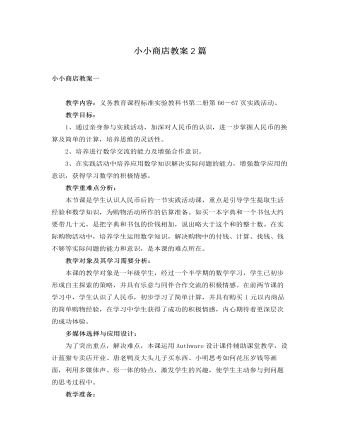
人教版新课标小学数学一年级下册小小商店教案2篇
3、同学们,你们看今天老师带来了什么?(出示一个学生喜欢的玩具)这是昨天老师去商店时买的,猜猜看,这个需要多少钱?(学生猜,教师可提示,最后得出正确标价)今天我们也来开个小小商店玩一玩买卖商品的游戏,想玩吗?4、选营业员及经理。我觉得当营业员最重要的是精通业务,计算能力强。谁想来当?(等学生举手后,教师选出4人。)考虑到我们呆会儿买的人会比较多,每个柜台一个营业员忙不过来,我还准备再选4名商店经理,做好以下几项工作:1)做好接待服务工作,顾客有困难能主动帮助。2)做好买卖过程中的组织工作,让大家有秩序地买商品。3)当营业员计算碰到困难时,两人能商量着解决。觉得自己能做到以上三点的同学可举手参加竞选。(学生举手后,选出4名经理)
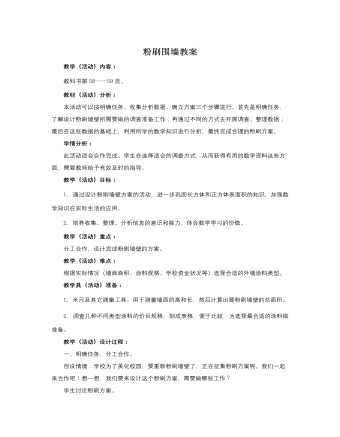
人教版新课标小学数学五年级下册粉刷围墙教案
(3)按每千克涂料粉刷3.5 m2计算,可求出共需要涂料:1600÷3.5≈460(千克);(4)根据涂料的型号及费用,选择合适的涂料。师:选择涂料时,要考虑很多因素,如价格、耐用期、消费心理、环保等,要怎么选择呢?学生可以把几种涂料进行对比,一起讨论决定,同时学会在交流中理解接纳别人较好的建议:如:A型,优点:价格便宜,需要19桶,总共才5700元;缺点:耐用期太短,两年后又要重新粉刷;B-1型和B-2型,虽然桶装量不同,但价格和耐用期都处在中游水平;C型和D型,优点:耐用期长,最划算;缺点:价格太高,不符合人们的消费心理,也不可能持续那么长时间,至少5年就要更换一下样子。综合以上价格、耐用期、消费心理,选择B-1或B-2型比较划算。而这两种比较来看,B-2型更便宜一些,所以,最后确立用B-2型涂料。
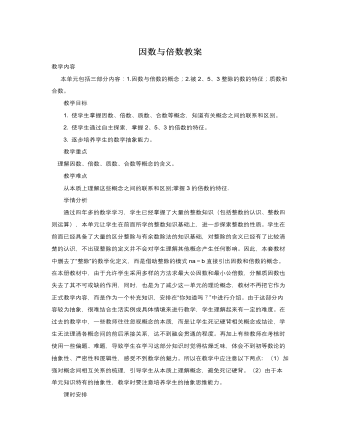
人教版新课标小学数学五年级下册因数与倍数教案
因此,本套教材中删去了“整除”的数学化定义,而是借助整除的模式na=b直接引出因数和倍数的概念。在本册教材中,由于允许学生采用多样的方法求最大公因数和最小公倍数,分解质因数也失去了其不可或缺的作用,同时,也是为了减少这一单元的理论概念,教材不再把它作为正式教学内容,而是作为一个补充知识,安排在“你知道吗?”中进行介绍。由于这部分内容较为抽象,很难结合生活实例或具体情境来进行教学,学生理解起来有一定的难度。在过去的教学中,一些教师往往忽视概念的本质,而是让学生死记硬背相关概念或结论,学生无法理清各概念间的前后承接关系,达不到融会贯通的程度。再加上有些教师在考核时使用一些偏题、难题,导致学生在学习这部分知识时觉得枯燥乏味,体会不到初等数论的抽象性、严密性和逻辑性,感受不到数学的魅力。所以在教学中应注意以下两点: (1)加强对概念间相互关系的梳理,引导学生从本质上理解概念,避免死记硬背。(2)由于本单元知识特有的抽象性,教学时要注意培养学生的抽象思维能力。
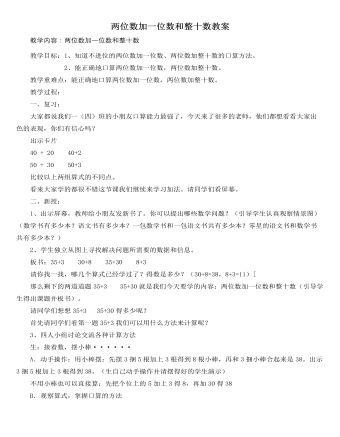
人教版新课标小学数学一年级下册两位数加一位数和整十数教案
二、新授:1、出示屏幕,教师给小朋友发新书了。你可以提出哪些数学问题?(引导学生认真观察情景图)(数学书有多少本?语文书有多少本?一包数学书和一包语文书共有多少本?零星的语文书和数学书共有多少本?)2、学生独立从图上寻找解决问题所需要的数据和信息。板书:35+3 30+8 35+30 8+3请你找一找,哪几个算式已经学过了?得数是多少?(30+8=38,8+3=11)[那么剩下的两道道题35+3 35+30就是我们今天要学的内容:两位数加一位数和整十数(引导学生得出课题并板书)。请同学们想想35+3 35+30得多少呢?首先请同学们看第一题35+3我们可以用什么方法来计算呢?3、四人小组讨论交流各种计算方法生:接着数,摆小棒······A.动手操作:用小棒摆:先摆3捆5根加上3根得到8根小棒,再和3捆小棒合起来是38。出示3捆5根加上3根得到38。(生自己动手操作并请摆得好的学生演示)不用小棒也可以直接算:先把个位上的5加上3得8,再加30得38B.观察算式,掌握口算的方法
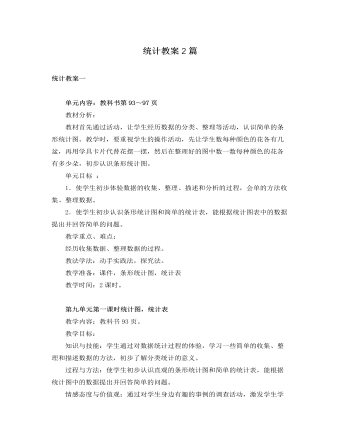
人教版新课标小学数学一年级下册统计教案2篇
2、揭题:小朋友们,知道吗?刚才你们的学习过程其实就是统计的过程,这节课我们就一起来研究统计的有关知识。3、发统计图和统计表:根据你刚才收集的数据,完成统计图和统计表。实践活动(调查全班小朋友们喜欢的动物)统计表:(学具卡片)绿孔雀非洲象大熊猫袋鼠梅花鹿河马统计图:(学具卡片)绿孔雀非洲象大熊猫袋鼠梅花鹿河马4、出示统计图和统计表。(1)通过小朋友们的统计,你能发现什么?(2)你可以提出什么问题?三、总结:1、日常生活中有许多事情可以用统计解决,你能说一说吗?2、谈谈这节课你的收获。作业布置:第二课时、练习教学内容:完成练习十七的2——4题。教学目标:巩固本单元所学的内容。教学过程:一、检查作业:1、小组互相交流自己调查的结果。2、展示几份。二、练习:练习十七1、第2题。(1)看图,明确题意。(2)先用自己喜欢的方法统计。(3)完成统计表及问题。(4)集体订正。
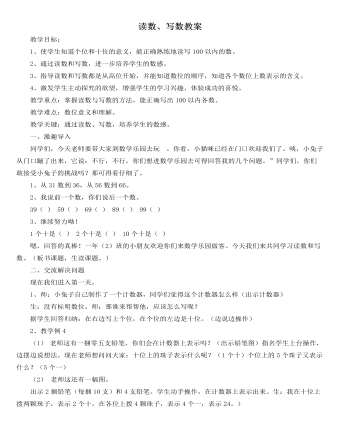
人教版新课标小学数学一年级下册读数、写数教案
教学目标:1、使学生知道个位和十位的意义,能正确熟练地读写100以内的数。2、通过读数和写数,进一步培养学生的数感。3、指导读数和写数都是从高位开始,并能知道数位的顺序,知道各个数位上数表示的含义。4、激发学生主动探究的欲望,增强学生的学习兴趣,体验成功的喜悦。教学重点:掌握读数与写数的方法,能正确写出100以内各数。教学难点:数位意义和理解。教学关键:通过读数、写数,培养学生的数感。一、激趣导入同学们,今天老师要带大家到数学乐园去玩 。你看,小猫咪已经在门口欢迎我们了。咦,小兔子从门口蹦了出来,它说:不行,不行,你们想进数学乐园去可得回答我的几个问题。”同学们,你们敢接受小兔子的挑战吗?那可得看仔细了。1、从31数到36,从56数到66。2、我说前一个数,你们说后一个数。
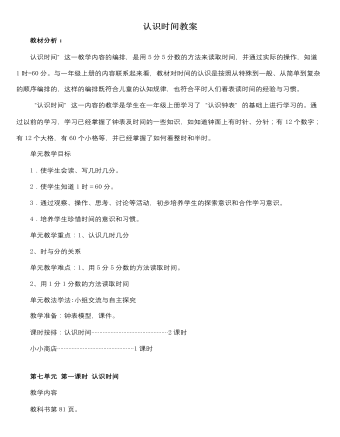
人教版新课标小学数学一年级下册认识时间教案
1.谁来扮演顾客,谁又来扮演售货员呢?(选出购物示范学生两名。)2.教师问顾客:你喜欢什么商品?准备去哪个柜台购买?(买什么。)3.你喜欢的商品标价是多少钱?(读价格。)4.你手里有多少钱?怎样付款?(算付款。)5.教师问售货员:顾客拿出了多少钱?他要买的商品是多少钱?(读价格。)6.你要找多少零钱给他?(算找零。)教师请其他学生观察这两名学生如何进行商品买卖,在买卖过程中有什么步骤。开始活动1.活动要求:顾客要检查售货员有没有找错零钱。2.卖易拉罐和矿泉水瓶的同学要检查废品回收员有没有算错一共应该付多少钱。3.售货员要看清顾客付款对不对。4.可以同学之间互相帮助,可以合伙购买。教师选定一部分学生扮演售货员,一两名学生扮演废品回收员,其余的扮演顾客。让学生根据自己的需要,利用人民币卡片购买商品、废品回收活动。在活动过程中,要让买卖双方互相检查对方在进行人民币计算时有没有发生错误。
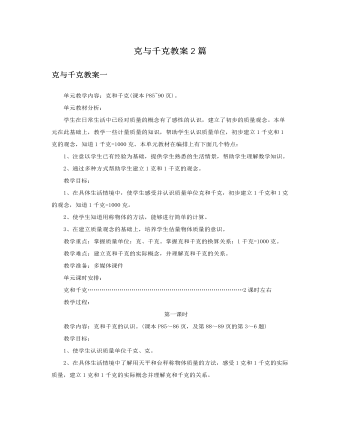
人教版新课标小学数学二年级下册克与千克教案2篇
教学目标1.使学生通过“称一称”的实践活动,亲自感受1克和1千克的实际重量。2.通过实践活动使学生加深质量单位的理解,让学生深刻体会到质量单位与实际生活是紧密联系的,在实际生活中是非常有用的。3.培养学生的动手能力及创新意识。4.培养学生与他人的合作意识和分工合作的精神。重、难点与关键1.进一步了解克和千克的质量单位概念。能够用老师提供的称,来称量物体质量。2.巩固对质量单位实际概念是认识。教具准备天平,盘秤,适量的生活用品,如水果,蔬菜等。教学过程一、创设情境同学们这节课老师带你们去超市逛一逛,想去吗?(出示课本第85页情境图)在超市里你看到了什么?指名回答。(饼干110克、豆油5千克、6个苹果1千克……)这些都表示什么意思呢?指名回答。教师说明表示物品有多重可以用克和千克作单位。那么在日常生活中有什么地方用到克与千克呢?举例说明。
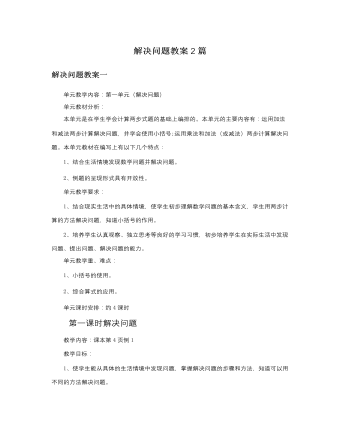
人教版新课标小学数学二年级下册解决问题教案2篇
(1)提问:用自己的话说一说画面的内容。根据画面的内容编一道应用题。可先让学生自由编题,然后出示:面包房一共做了54个面包,第一队小朋友买了8个,第二队小朋友买了22个,现在剩下多少个?(2)全班同学读题后提问:题目的已知条件和问题分别是什么?根据“一共做了54个面包,第一队小朋友买了8个”这两个条件可以求什么?(第一队买后还剩下多少个)怎样列式?【54-8=46(个)】那要求还剩下多少个?又该怎样列式?【46-22=24(个)】谁能列一个综合算式?【54-8-22=24(个)】(列好后,要求学生说出每一步算式的意义)教师:大家想一想还有没有不同的想法?(鼓励学生从不同角度去思考问题)根据“第一队小朋友买了8个,第二队小朋友买了22个”可以求出什么问题?(两队一共买了多少个面包?)可以怎样列式?【8+22=30(个)】那要求还剩下多少个?又该怎样列式?【54-30=24(个)】同桌的同学互相讨论一下:如果写成一个算式,应该怎样列式?
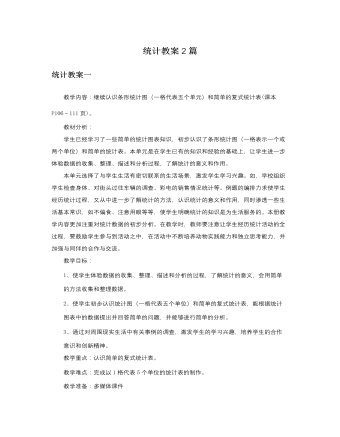
人教版新课标小学数学二年级下册统计教案2篇
2.采用比较简便的方法,师生合作完成“数据的收集与整理(强调数据的准确性),学生独立完成“表格的填写”。3.小组内讨论完成“表格的分析”。4.全班进行反馈。(意在培养独立收集、整理数据的能力,核对数据的准确性,并且扩大提问题的参与面,让学生也能启动智慧、享受快乐;及时反馈信息,调整教学目标)四、全课总结1.通过今天的学习,同学们有哪些收获?2.应用延伸。(课本第112页练习二十二第1题)五、布置作业教后反思统计是日常生产生活中常用和实用的工具,因此统计也是小学生必备的能力之一。但是统计的教学较为枯燥无味,教师往往会轻视统计的教学,忽略学生能力方面的培养。在教学统计时,老师要激发学生学习统计的兴趣,创造各种情景,加强学生统计中的动手实践操作训练,同时在实际生活中加以运用,并逐步加大难度和密度,同时也需要知道,统计教学不要过分地浮夸,多给予学生统计的意义,使其明确学习的目的。
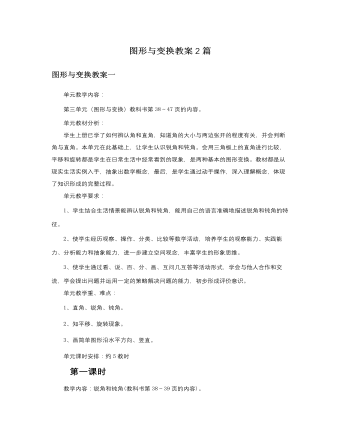
人教版新课标小学数学二年级下册图形与变换教案2篇
第二种分法:分成三类:直角是一类,比直角小的分为一类,比直角的的又分为一类。2.讨论交流,引导学生明确锐角和钝角的意义。教师:比直角小的就是直角的弟弟,比直角的的就是它的哥哥。我们来为它们起个名字好吗?让学生充分交流后引导小结:比直角小的叫锐角,比直角大的叫钝角。相互讨论:怎样判断一个角是不是锐角或钝角?学生讨论(得出和直角比、用眼睛看等方法)三、实践应用,巩固提高1.完成练习九的第1、2题。2.画一画:请你分别画出一个直角、锐角和钝角。四、游戏活动1.折一折,比一比。让学生利用身边的材料折出不同的角,并互相认一认是什么角?2.摸摸、猜猜。(分小组活动)活动规则:把一同学眼睛蒙住,另一同学用活动角掰成大小不同的角,让蒙住眼睛的同学通过手摸后说出是什么角?其他同学当裁判。然后组内同学交换活动。五、全课总结这节课我们学习了什么?你有哪些收获?六、布置作业
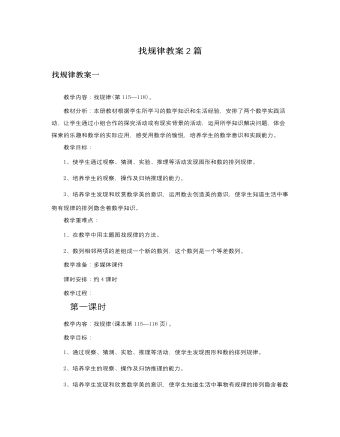
人教版新课标小学数学二年级下册找规律教案2篇
1.动物园里举行运动会,小动物可高兴了,你瞧,他们排着整齐的队伍走出来了。老师分步出示图片,让学生观察,你发现了什么?第一步逐一贴出图片;小熊、兔子、猴子、青蛙;第二步逐一贴出图片:兔子、猴子、青蛙、小熊;第三步逐一贴出图片:猴子、青蛙、小熊、兔子;第四步怎样贴呢,学生试贴:青蛙、小熊、兔子、猴子。教师:为什么这样贴呢?说出你的理由。2.观察整幅方阵图,你们发现了什么?3.请四个学生上台问及此事,做类似方阵图中动物的排列,四位同学不停的变换位置。(体会其中循环排列的含义)教师:深入观察,你们还发现了什么?教师:刚才同学们用自己的语言形容出其中的排列规律;我们可以说这种排列方式是循环排列的规律。4.小东家搞装修,房子是怎样布置的呢?我们一起参观参观,有什么规律呢?学生讨论讲解:墙面与地面都是循环排列的规律。
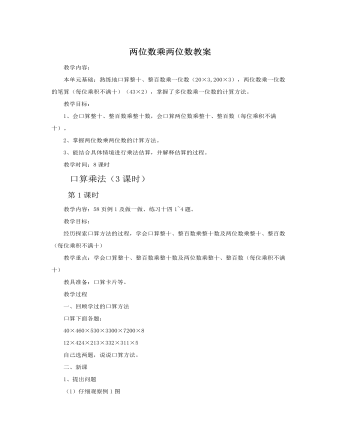
人教版新课标小学数学三年级下册两位数乘两位数教案
(1)学生笔算。(2)请学生观察比较:上行的题目和下行的题目有什么异同?(3)学生讨论交流:它们的计算方法是一样的,不同的是上行的题目计算时没有进位,而下一行的题目需要进位。(4)说说笔算乘法要注意什么?4、正误辩析:教师用小黑板出示6道计算出现错误的笔算式题,让学生判断正误,并进行改正。二、解决问题:1、完成练习十六第3题:(1)引导学生看图,获取信息。(2)同桌互相说:把图上的意思完整的说一说。(3)独立列出算式,并用竖式笔算。(4)集体讲评。2、学生独立完成练习十五第4题、第8题。第8题:在解决这道题时,是不是所有的信息都用上?为什么“每套12张”用不上?这样的题目给了你什么启示?三、综合练习:独立完成练习十六第5、6、7题。四、学习总结:说说这节课有什么收获?笔算乘法要注意什么?
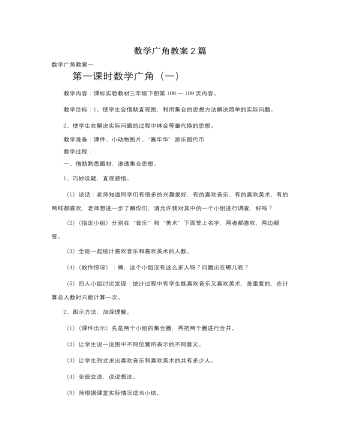
人教版新课标小学数学三年级下册数学广角教案2篇
1、同学们都听说过“曹冲称象”的故事吧!曹冲是怎么称出大象的重量的呢?让我们一起来回顾这一过程。2、曹冲是把大象的重量转换成了什么的重量呢?【他是把大象的重量转换成了与它重量相等的石头的重量】因为当时没有那么大的称能直接称出大象的重量,所以曹冲就用石头的重量代换了大象的重量,称出了石头的重量也就知道了大象的重量。3、同学们,你们大概还不知道吧,曹冲确实非常了不起,他运用了一种重要的数学思考方法——等量代换。【板书:数学广角——等量代换】这节课我们就来学习如何用“等量代换”的方法解决问题。二、引导探究发现规律1、今天这节课,老师给同学们带来了神秘的礼物。猜猜,什么样的孩子能够得到它们?全班?个大组,哪组的成员在参与过程中积极主动,认真动脑思考,遵章守纪,老师就奖励这个组一个青苹果,三个青苹果可以换一个红苹果,两个红苹果可以换取一份神秘的礼物。看看哪个组能得到礼物。有信心吗?老师相信你们是最棒的。
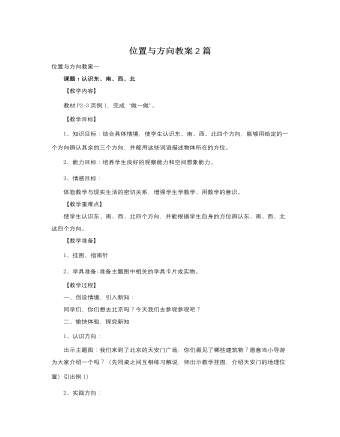
人教版新课标小学数学三年级下册位置与方向教案2篇
【教学目标】1、知识目标:结合具体情境,使学生认识东、南、西、北四个方向,能够用给定的一个方向辨认其余的三个方向,并能用这些词语描述物体所在的方位。2、能力目标:培养学生良好的观察能力和空间想象能力。3、情感目标:体验数学与现实生活的密切关系,增强学生学数学、用数学的意识。【教学重难点】使学生认识东、南、西、北四个方向,并能根据学生自身的方位辨认东、南、西、北这四个方向。【教学准备】1、挂图、指南针2、学具准备:准备主题图中相关的学具卡片或实物。【教学过程】一、创设情境,引入新知:同学们,你们想去北京吗?今天我们去参观参观吧?二、愉快体验,探究新知1、认识方向:出示主题图:我们来到了北京的天安门广场,你们看见了哪些建筑物?愿意当小导游为大家介绍一个吗?(先同桌之间互相练习解说,师出示教学挂图,介绍天安门的地理位置)引出例1)
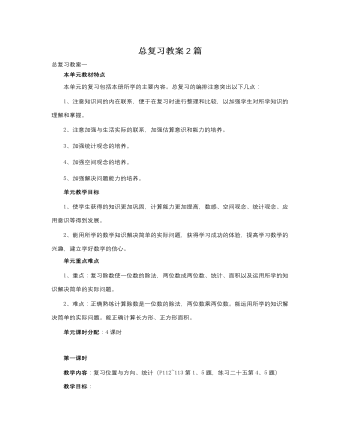
人教版新课标小学数学三年级下册总复习教案2篇
2、复习除数是一位数的除法时,通过让学生做第112页的第2题,了解学生计算时还存在什么问题,启发、引导学生发现自己的错误所在,并通过反思自己纠正;还应注意通过一定的练习使学生达到计算熟练。3、复习两位数乘两位数时,结合第113页第3题复习口算,结合第4题复习估算和笔算。教师针对计算中出现的问题进行订正,再通过练习二十五中的有关练习或出一些有针对性的练习,使全体学生达到本学期规定的教学目标。总复习:课题二1、复习统计时,让学生分析第113页第5题中的数据,对近年来该地区沙尘天气的发展变化趋势有一个判断;让学生谈谈感想,有什么办法减少沙尘天气,使学生受到环境保护的思想教育。2、复习年、月、日时,要注意全面复习学过的时间单位和有关知识,可借助表格进行系统整理时间单位,结合实例让学生体会这些单位的大小,培养学生的估计能力。
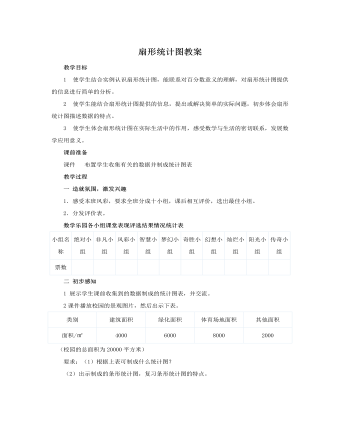
人教版新课标小学数学六年级下册扇形统计图教案
2 根据下面4幅,你能判断出哪个学校的女生人数最多吗?(1) 如果甲校的学生总人数900人,那么甲校的女生有多少人?(2) 如果丙校男生与甲校的同样多,那么丙校学生总人数有多少人?(3) 如果乙校的学生总人数与丙校的同样多,那么乙校男生有多少人?(4) 如果丁校的男生与乙校的同样多,那么乙校的女生有多少人?3 出示课件《中国人口占世界的百分比》和《中国国土面积占世界的百分比》统计图和有关的数据。(1)中国人口约13亿 (2)中国国土面积约960万平方千米(请同学认真观察统计图和有关的数据,请你说说获得了哪些信息?并提出我们能够解决的问题。要求:先在小组交流,然后派代表提出问题,并指定他组回答,其他同学当评委;如果回答正确,由的同学提问题,否则,由提问题的同学继续提问。同组成员可帮助。)还有什么想法?3 出示西山村果园各种果树种植面积情况,要求学生根据给出的数据制成扇形统计图。





















